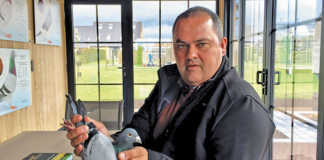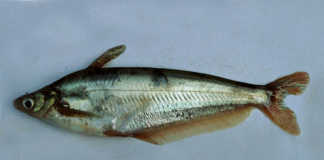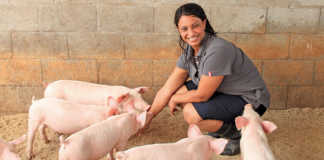James Faber started farming Dorper sheep and Boer goats near Delportshoop on the Ghaap Plateau 24 years ago, but a high level of predation made the operation increasingly unfeasible. The problem was triggered by a growing warthog population. James says that nobody really knows how warthog were introduced to the plateau, but the damage they inflicted on jackal-proof fencing allowed unhindered entry of predators such as black-backed jackal, caracal and even brown hyena into the farm.
“Warthog have few, if any, natural enemies here, allowing their numbers to escalate,” James explains.
Stud breeding
After careful consideration, he decided to convert his farming operation to beef cattle stud breeding, as he believed it would offer a higher return on investment than commercial beef production. James and his brother Gert own Glen Ross Farming about 70km from Kimberley. James is in charge of livestock and Gert manages crop production.
The livestock component consists of a Brangus stud, a Nguni stud, a 500-strong commercial cattle herd, and a cattle feedlot with a capacity of 500 weaners. The crop division produces maize, barley, seed sunflower, and lucerne. The livestock division represents about 40% of farm turnover.
The soils on Glen Ross consist mostly of calcrete. About half the vegetation is made up of vaalbos or silver cluster leaf (Terminalia sericea) and wild olive (Olea europaea subsp. africana), while the remaining area is dominated by black thorn (Acacia mellifera). Other woody vegetation includes camel thorn (Acacia erioloba), shepherds’ tree (Boscia albitrunca), and sweet thorn (Acacia karroo).
The sweetveld grasses include blue buffalo grass (Cenchrus ciliaris), thimble grass (Fingerhutia africana), and white buffalo grass (Panicum coloratum). The average rainfall on the farm is 360mm. Temperatures can soar to more than 40°C in summer and fall to below zero in winter. The stocking rate on Glen Ross is adapted according to the condition of the veld.
The breeds that James selected for his stud operation had to be hardy and adapted to the extensive ranching conditions of the Northern Cape. They also had to add maximum value to his enterprise. Among other factors, he selected breeds based on the nature of the farming environment, the objective of his farming enterprise and his subjective opinion of the breeds.
“I wanted breeds that appealed to me. That’s why I decided on Brangus and Nguni,” he recalls. “A breeder chooses a breed he is most attracted to, but adaptability is nevertheless non-negotiable. When I select for function, the correct form will follow.”

James Faber
Fertility
Fertility is the main breeding criterion in the Glen Ross Brangus and Nguni studs. The Nguni stud consists of 200 cows and 50 replacement heifers and the Brangus stud of 300 cows and 150 heifers. James maintains summer and winter breeding seasons, running multi-sire breeding herds with one bull per 20 females. Using artificial insemination on a very small scale introduces new genetics into the herds.
James is hesitant to reveal his studs’ breeding statistics. He does, however, aim to improve the intercalving period (ICP) of both. The Brangus herd’s ICP currently stands at 390 days and that of the Nguni herd at 355 days. In both herds, any cow failing to conceive annually is slaughtered.
“Calving ease is crucial, given our extensive farming conditions,” he adds. “It’s impossible for me to keep track of each pregnant cow on a daily basis. In both breeds, a low birth weight contributes to our very low calving problem rate. We simply cannot afford to lose calves through calving problems. The ideal Brangus and Nguni cow weans a relatively heavy calf for a high weaning weight ratio.”
The Glen Ross Brangus and Nguni cows’ strong maternal characteristics and above-average milk production make them ideally suited to this semi-arid ranching environment. The Brangus is also selected for a stable temperament, making the veld-reared animals easy to handle in a kraal or a crush. A strong walking ability is essential, given the extensive nature of the beef ranching operation.
James’s main clients are commercial cattlemen and he keeps their profit margin foremost in his mind when formulating his own breeding objectives. If it goes well with the commercial cattle sector, it will also go well with the stud breeding sector, he explains.
As chairman of the Northern Cape Red Meat Producers’ Organisation, James laments the fact that unscrupulous breeders – ‘cowboys’, as he calls them – continue to sell bulls carrying sexually transmitted diseases such as trichomoniasis and vibriosis that cause infertility and abortions. Every Glen Ross bull is tested for fertility and both diseases before being put up for sale. Certified bulls brought in are kept in quarantine for at least 21 days before being introduced to the herds.
“Vibriosis and trichomoniasis can wipe out an entire herd,” he says. “Prospective buyers should only buy bulls that are certified free from these diseases.”
Simplified health programme
The dry climate simplifies the herd health programme. Each year, the herds are inoculated against black quarter, anthrax and botulism, as well as bovine viral diarrhoea and brucellosis. Ectoparasites such as ticks pose much less of a problem in the hot, dry environment, and due to both breeds’ natural resistance.
The cow herds are divided into smaller sub-herds of between 40 and 90 animals, depending on the camp size and amount of forage available. Records are kept of every animal’s performance and cattle are not moved unnecessarily between groups. Small breeding herds enable him to monitor of each bull’s performance and keep an efficiency record.
Providing a summer phosphate lick, a winter protein lick and a flush feed lick for cows at the start of the breeding season is standard practice. James mixes his own licks and monitors lick intake carefully as indicator of the nutritional value of the forage: an increased lick intake indicates a deterioration in the veld’s nutritional value, and vice versa.
Veld management
A grazing and veld management programme, developed in conjunction with veld and pasture management specialist Dr Louis du Pisani, forms the backbone of the Glen Ross cattle operation.
“If we look after the veld on our farm, our farm will take care of us, even during the most difficult times,” James stresses. “The objective is to improve grazing and conserve the natural habitat, the most important resource we have. We started this long-term undertaking eight years ago. Dr Louis and I inspect each camp annually to work out a programme for the next year’s stocking rate, the number of grazing days, and the camps to be rested. The grazing programme also extends to land that I lease. It’s crucial that we care for the veld for sustainable and profitable long-term production.”
The Glen Ross land is divided into 150 camps, each grazed three times a year for a total of about 200 days. James nevertheless admits that the number of grazing days is not carved in stone, as it is far more important to graze a camp to its full potential. This means that the number of grazing days can differ from year to year.
Each camp has its own watering point. The camps are grouped into 12 clusters, each with a cattle post. Between 25% and 30% of the camps are rested for a full year, from 1 July to 30 June the next year. James has embarked on a selective black thorn control and management programme, in which a portion of the trees are killed with a herbicide. The rest of the population is retained as the black thorn is endemic to the area and a valuable browse.
New approach
One of the mind-shifts James had to undergo was to stock fewer animals per hectare for increased production and consequently a greater profit margin. “Through proper veld management, increased and nutritionally improved grazing, we can increase individual animal production considerably,” he explains. “Increasing production by just 2% to 3% will make a big difference to the farm’s overall profitability. We’re still in the process of determining the ideal weight of beef produced per hectare.”
His long-term goal is to contribute to prolonged and profitable food production in South Africa.
“One of the ways to achieve this is to increase production in the beef industry,” he says. “The national weaning rate in South Africa is estimated at about 60%. This is unacceptable. If the weaning rate is increased, we could become self-sufficient in red meat and even start exporting.”
Production can be increased through improved genetics, improved bio-security measures, and looking after our natural resources, he insists.
Phone James Faber on 083 292 2556 or email him at [email protected].













